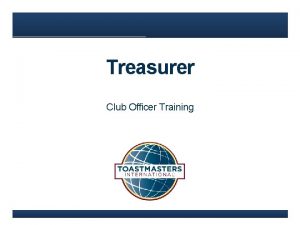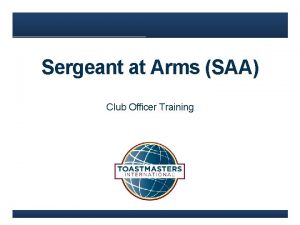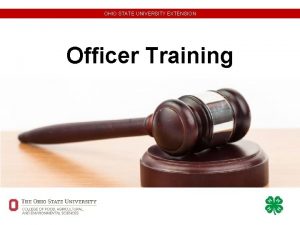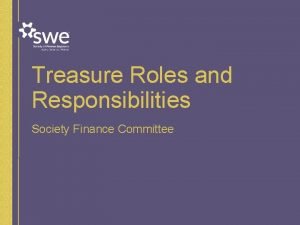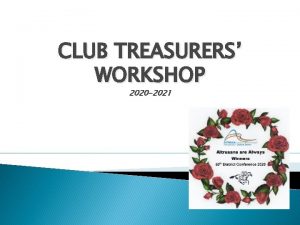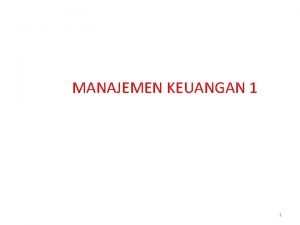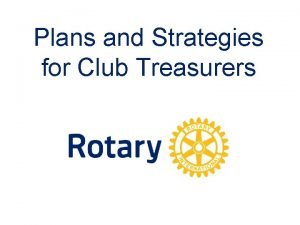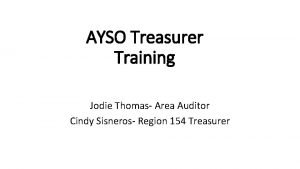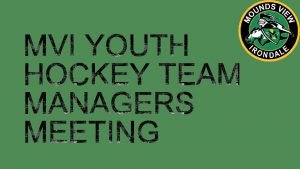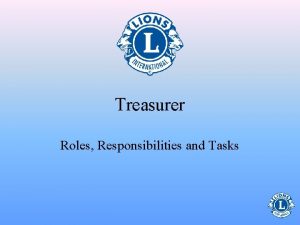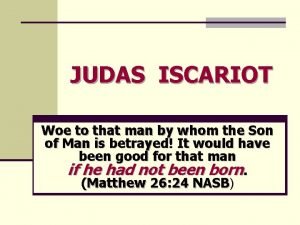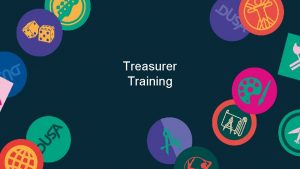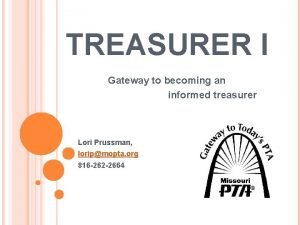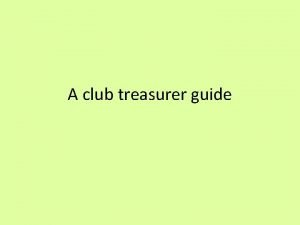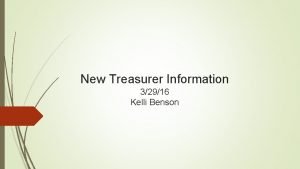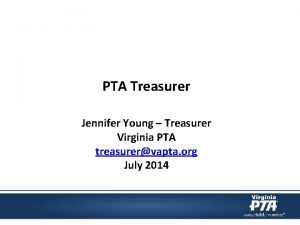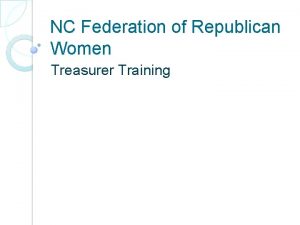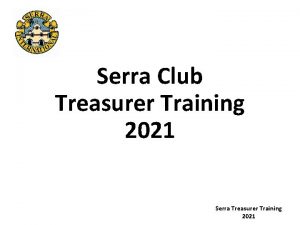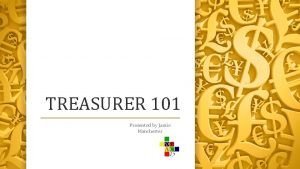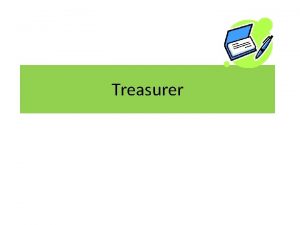The Expanding Role of the Treasurer Are they
















- Slides: 16

The Expanding Role of the Treasurer: Are they the new Co-CFO? Information herein is considered proprietary and confidential.

The CFO and the Treasurer CFO The person who is responsible for accounting, budgeting, financial analysis and the oversight of insurance, health insurance, real estate, banking, accounts receivable and legal issues. The CFO is the highest financial officer in a company. This position often works in conjunction with the Chief Executive Officer, or CEO, and reports directly to the owner of the company or the board of directors. Treasurer The person who is responsible for managing financial risk for the company across credit, currency, interest rates and operations. In business, a CFO generally oversees the performance of a Treasurer. The Treasurer’s primary responsibility is to ensure the organization has adequate liquidity to meet its ongoing requirements 2

It’s a changing world The world has changed a lot in the past 10 years. The rapid development of new technology and the changing landscape of the online world has changed the way we work and, for many, where we do our work from. • There were 972 million internet users in 2005. Today there is over 3 billion. • By 2013, there were officially more mobile devices than people on earth. • In 2005 only 68. 7 % of adult Americans owned a cell phone and a mere 42% said they leave their cell phone on “Always”. • 10 Years ago our pockets weren’t large enough to hold a music player. Today, streaming via the cloud is the norm with 75% of the population saying they listen to music online. 3

4

CFO - The Brave New Leader The duties of the CFO have changed dramatically in the post-Sarbanes-Oxley/market meltdown world. CFO’s have emerged as key business partners to the CEO. • The Best CFOs balance accountability to shareholders for maintaining the integrity of the financial statements and for applying risk management while being loyal to the CEO. • CFO’s increasingly contribute to organizational strategy and are meeting unprecedented demand for their unique perspective and discipline. • The CFO remains an objective voice of financial performance but contributes to operational decision making as well. • CFO’s manage or materially support information technology, investor relations, real estate and strategic M&A… and some are involved in commercial activities. • The necessity in controlling cost, managing risk and maintaining liquidity has been brought to the foreground by the financial crisis… and this necessity persists. 5

The changing role of the treasurer Post 2008 Closer scrutiny by the board Strategic partner in the company Closer interaction with business units Broader skillset required 1980’s to 2008 Improvement in technology More Sophisticated risk management Centralization of roles and processes 1980’s Focus on operational activities New Financial Instruments 6

The Treasurer: the new focal point Treasurers used to work to monitor the day-to-day finances of a business, but now with the advances in technology and expansion of the CFO role, has created a shift in their job responsibilities. • A Treasurer, also known as a certified treasury professional in certain job settings, oversees the long-term and short-term budgetary goals of a business. • They work in tandem with other corporate executives in order to create and meet the quarter-to-quarter budgetary benchmarks as instructed by the CEO. • Treasurers focus more of their time on raising capital, coordinating mergers, and doing due-diligence on possible acquisition targets to further the success of the business. • Treasurers may also directly oversee a business or in-house financial department where their duties may consist of developing inventive strategies to reduce workplace costs and raise efficiency. 7

The Treasurer in 2016 Core Responsibilities • Cash and liquidity funding • Finance • Risk management • Operations • Deal execution • Relationships • Valuation and Appraisals External Environment • Regulation • Markets • Events Corporate Strategy • Link into financial strategy and risk appetite Enablers • Use of systems and technology • Process automation, standardization and simplification Performance and Reporting • Measurable KPIs • Accurate and timely reports 8

The Treasurer’s new role Today the Treasurer must take a more strategic role, providing greater insight into the company’s return proposition vs operational risk. • The Treasurer must manage risk holistically while maximizing returns and minimizing idle funds. • Enhanced supervision and forecasting of liquidity and funding needs. • Proactively establishing the right policies, procedures and governance to protect financial assets in response to changing business strategies, conditions and external market factors. • Implementing, integrating and optimizing technology to enable proactive and data-driven decision making. • Building relationships with external funding partners to ensure adequate access to capital requirements with reasonable terms and costs. 9

Finances new powerhouse duo As Treasurers are asked to do more by their CEO’s, CFO’s and Boards, the traditional definition of their job duties begins to look increasing similar to the duties of a CFO. Let’s look at some key strategies to be successful in their expanded role. • Be Forward Looking • Implement a Financial Strategy that is not contingent on market conditions • Keep a close eye on risk • Cultivate strong relationships 10

Where we are today • Evolution of the Treasury Department o Leaner departments o Additional responsibilities o New duties • Challenging Environment o Economic climate o Regulatory environment o Cybercrime • Managing Limited Resources o Budgets o Capabilities o FTE 11

Optimize your current environment Top Priorities for Treasury • • Manage risks effectively Improve treasury process efficiency Optimize borrowing costs Optimize income generation Improve cash conversion cycle Improve process security Minimize banking fees 12

Top issues for Treasury departments in 2016 • The demand for higher efficiency in treasury, money flows, cash management and A/R and A/P • More duties that were previously accounting and finance duties are being pushed to treasury operations • Significant changes in customer payment trends • Annual price increases and changing bank pricing strategies for treasury services • Continued low staffing levels • The threat of rising interest rates • Capital preservation vs. capital appreciation 13

Reliance on outside resources As corporate treasury needs become increasingly complex and individual in nature, demand is growing for more sophisticated, flexible and sustainable cash management solutions that tie in with the trend for concentrating on the long term. • • • Banks Vendors Associations and events Periodicals Consultants/advisors 14

Best practices • Utilize experts and advisors within the treasury and payments field to maximize efficiencies and reduce the direct and indirect costs of treasury and payments operations • Ensure your treasury and payments operations are ‘best in class’ within your market • Continuously benchmark processes, systems, functions, services and fees against industry standards • Regularly review business and economic climate with industry experts • Critically evaluate and optimize treasury and payments efficiencies by understanding and scrutinizing systems, technology and processes associated with money flowing into and out of the business • Ensure regulatory and compliance functions are up to date 15

Thank you for your time Information herein is considered proprietary and confidential. 16
 Antigentest åre
Antigentest åre Toastmasters treasurer role
Toastmasters treasurer role Saa club
Saa club Osu treasurer training
Osu treasurer training Treasure role
Treasure role Ffa reporter symbol
Ffa reporter symbol Treasurer duties in a club
Treasurer duties in a club Financial decision adalah
Financial decision adalah How to be a treasurer for a club
How to be a treasurer for a club Ffa officer duties
Ffa officer duties Jodie thomas
Jodie thomas What does the owl represent in the ffa emblem?
What does the owl represent in the ffa emblem? Treasurer duties
Treasurer duties President vice president treasurer secretary
President vice president treasurer secretary Aa treasurer spreadsheet
Aa treasurer spreadsheet Lions club treasurer duties
Lions club treasurer duties Judas iscariot treasurer
Judas iscariot treasurer

